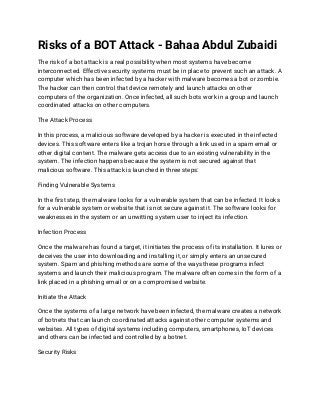
Risks of a BOT Attack - Bahaa Abdul Zubaidi.pdf
- 1. Risks of a BOT Attack - Bahaa Abdul Zubaidi The risk of a bot attack is a real possibility when most systems have become interconnected. Effective security systems must be in place to prevent such an attack. A computer which has been infected by a hacker with malware becomes a bot or zombie. The hacker can then control that device remotely and launch attacks on other computers of the organization. Once infected, all such bots work in a group and launch coordinated attacks on other computers. The Attack Process In this process, a malicious software developed by a hacker is executed in the infected devices. This software enters like a trojan horse through a link used in a spam email or other digital content. The malware gets access due to an existing vulnerability in the system. The infection happens because the system is not secured against that malicious software. This attack is launched in three steps: Finding Vulnerable Systems In the first step, the malware looks for a vulnerable system that can be infected. It looks for a vulnerable system or website that is not secure against it. The software looks for weaknesses in the system or an unwitting system user to inject its infection. Infection Process Once the malware has found a target, it initiates the process of its installation. It lures or deceives the user into downloading and installing it, or simply enters an unsecured system. Spam and phishing methods are some of the ways these programs infect systems and launch their malicious program. The malware often comes in the form of a link placed in a phishing email or on a compromised website. Initiate the Attack Once the systems of a large network have been infected, the malware creates a network of botnets that can launch coordinated attacks against other computer systems and websites. All types of digital systems including computers, smartphones, IoT devices and others can be infected and controlled by a botnet. Security Risks
- 2. Botnets create different security risks for systems and organizations affected by it. Data theft is a major security risk of a botnet attack. The hacker can use this technique to steal financial data, trade secrets and customer information. The stolen data allows the hacker to commit fraud or simply sell the data in the underground market. The affected company can suffer financial loss and reputation damage. The botnet can corrupt or delete files. When the data is corrupted, lost or stolen, it creates many problems for the affected organization. The company can face legal problems when it is unable to provide services as promised. Its customers and clients can switch to other competitors. It is expensive to fix all these problems. The losses can be extensive if the data cannot be recovered. A company must educate its employees and users about phishing and spam attacks. It should use security solutions to eliminate the risk of botnets and prevent data loss. Bahaa Abdul Zubaidi
